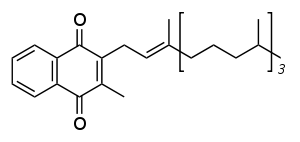Haemorrhagic disease of the newborn
Haemorrhagic disease of the newborn, also known as vitamin K deficiency bleeding (VKDB), is a coagulation disturbance in newborn infants due to vitamin K deficiency. As a consequence of vitamin K deficiency there is an impaired production of coagulation factors II, VII, IX, X, protein C and protein S by the liver, resulting in excessive bleeding (hemorrhage).
| Haemorrhagic disease of the newborn | |
|---|---|
| Other names | Vitamin K deficiency bleeding |
 | |
| Vitamin K1 | |
| Specialty | Pediatrics |
Signs and symptoms
The disease causes an increased risk of bleeding. The most common sites of bleeding are the umbilicus, mucous membranes, gastrointestinal tract, circumcision and venepunctures.
Causes
Newborns are relatively vitamin K deficient for a variety of reasons. They have low vitamin K stores at birth, vitamin K passes the placenta poorly, the levels of vitamin K in breast milk are low and the gut flora has not yet been developed (vitamin K is normally produced by intestinal bacteria).
Diagnosis
Precise diagnosis by measuring proteins induced by vitamin k absence (PIVKA). But this is usually not required.
Treatment
Treatment consists of vitamin K supplementation.[1] This is often given prophylactically to newborns shortly after birth.
United States
As a result of the occurrences of vitamin K deficiency bleeding, the Committee on Nutrition of the American Academy of Pediatrics has recommended 0.5–1 mg of vitamin K1 be administered to all newborns shortly after birth.[2]
United Kingdom
In the UK, vitamin K supplementation is recommended for all newborns within the first 24 hours.[3] This is usually given as a single intramuscular injection of 1 mg shortly after birth but as a second-line option can be given by three oral doses over the first month.[4]
Controversy
Controversy arose in the early 1990s regarding this practice, when two studies suggested a relationship between parenteral administration of vitamin K and childhood cancer.[5] However, poor methods and small sample sizes led to the discrediting of these studies, and a review of the evidence published in 2000 by Ross and Davies found no link between the two.[6] Doctors reported emerging concerns in 2013,[7] after treating children for serious bleeding problems. They cited lack of newborn vitamin K administration as the reason that the problems occurred, and recommended that breastfed babies could have an increased risk unless they receive a preventative dose.
References
- Hubbard D, Tobias JD (November 2006). "Intracerebral hemorrhage due to hemorrhagic disease of the newborn and failure to administer vitamin K at birth". South. Med. J. 99 (11): 1216–20. doi:10.1097/01.smj.0000233215.43967.69. PMID 17195415.
- American Academy of Pediatrics Committee on Fetus Newborn (July 2003). "Controversies concerning vitamin K and the newborn. American Academy of Pediatrics Committee on Fetus and Newborn" (PDF). Pediatrics. 112 (1 Pt 1): 191–2. doi:10.1542/peds.112.1.191. PMID 12837888.
- Logan S, Gilbert R (1998). "Vitamin K For Newborn Babies" (PDF). Department of Health. Archived from the original (PDF) on 7 January 2013. Retrieved 12 Oct 2014.
- "Postnatal care: Routine postnatal care of women and their babies [CG37]". www.nice.org.uk. NICE. Jul 2006. Retrieved 12 Oct 2014.
- Parker L, Cole M, Craft AW, Hey EN (January 1998). "Neonatal vitamin K administration and childhood cancer in the north of England: retrospective case-control study". BMJ. 316 (7126): 189–93. doi:10.1136/bmj.316.7126.189. PMC 2665412. PMID 9468683.
- McMillan DD, et al. (Canadian Paediatric Society, Fetus and Newborn Committee) (1997). "Routine administration of vitamin K to newborns". Paediatrics & Child Health. 2 (6): 429–431. doi:10.1093/pch/2.6.429.
- "Newborns get rare disorder after parents refused shots".
Having four cases since February just at Vanderbilt was a little bit concerning to me
External links
| Classification | |
|---|---|
| External resources |